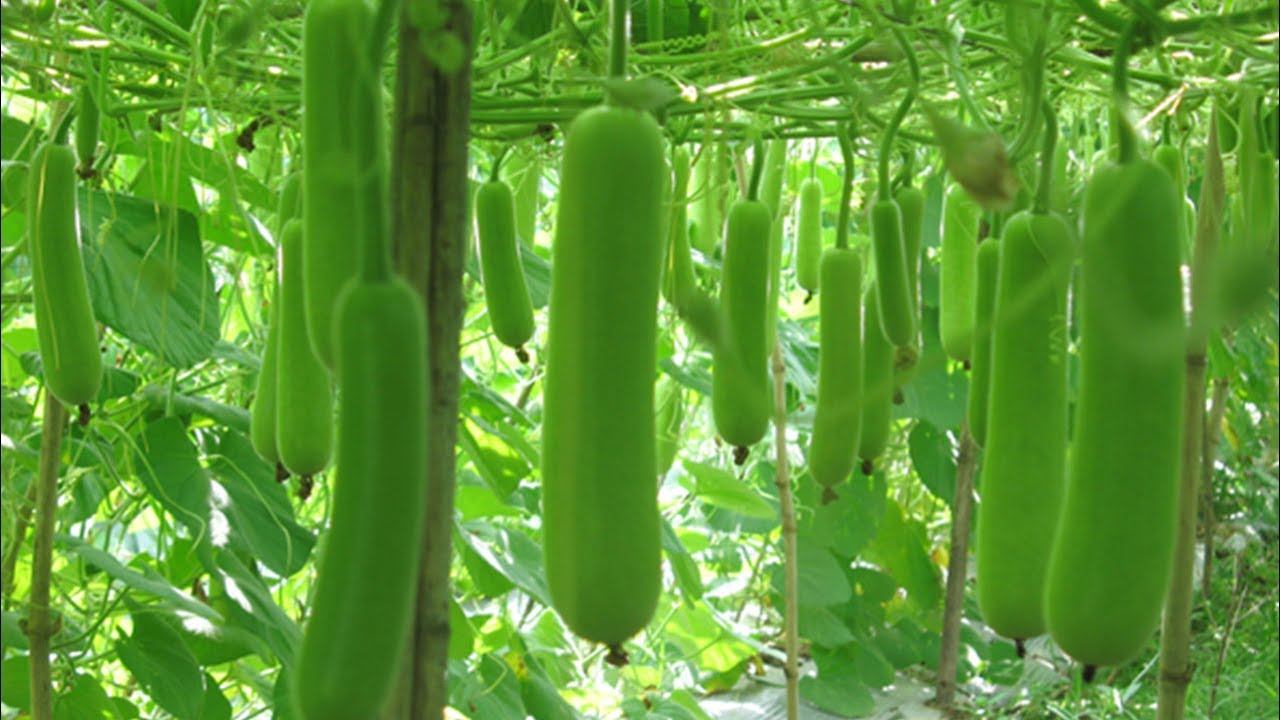Guide to Bottle Gourd Farming in India: All You Need To Know
Bottle Gourd Farming in India

In the vast tapestry of Indian agriculture, bottle gourd, also known as “Lauki” or “Ghiya,” has carved out its unique niche as a versatile and economically important crop. Bottle gourd farming is a source of livelihood for countless farmers and a valuable dietary staple in many households across India.
This comprehensive guide will delve into bottle gourd farming, exploring its cultivation techniques, potential benefits, challenges, and role in Indian agriculture.
1. Understanding Bottle Gourd
Bottle gourd, scientifically known as Lagenaria siceraria, is classified as a warm-season crop within the Cucurbitaceae family. Its distinctive features include elongated, bottle-shaped fruits, which span a size range from one foot to several feet. These fruits are commonly enjoyed as vegetables and celebrated for their gentle flavour and notable water content.
2. Varieties of Bottle Gourd
Several bottle gourd varieties in India are cultivated, each with unique characteristics. Some popular types include:
- Pusa Summer – Known for its high yield potential and resistance to diseases.
- Pusa Naveen – Preferred for its uniform fruit shape and good keeping quality.
- Pusa Upvan – Favored for its early maturity and prolific fruiting.
- Pusa Barsati – Suited for rainy season cultivation, it has good disease resistance.
3. Climate and Soil Requirements
Bottle gourd thrives in warm, tropical, and subtropical climates, ideally within the temperature range of 25°C to 35°C for optimal growth. However, it’s crucial to emphasise that this crop is highly sensitive to frost and cannot endure low temperatures.
Regarding soil preferences, bottle gourd favours well-drained, loamy, or sandy loam soil with a pH level falling within the range of 6.0 to 7.0. Sufficient organic matter in the soil boosts its fertility and enhances its capacity to retain moisture, promoting an environment conducive to successful bottle gourd cultivation.
4. Propagation
Seeds primarily propagate bottle gourd. Farmers can purchase high-quality seeds from reputable suppliers or save them from their previous harvests. Seeds should be soaked in water for 24 hours before sowing to improve germination rates.
5. Land Preparation and Planting
Here are the key steps involved in land preparation and planting:
- Ploughing: Begin by ploughing the field using a reliable Mahindra 585 or Mahindra Arjun 605 to break the soil and make it suitable for planting.
- Harrows and Levelling: Use harrows to refine the soil texture and ensure an even surface.
- Ridge and Furrow System: Create ridges and furrows to aid irrigation and drainage.
- Spacing: Plant bottle gourd seeds at a distance of 2.5 to 3 feet between rows and 1.5 to 2 feet between plants within a row.
6. Irrigation
Bottle gourd requires regular and consistent moisture. Drip irrigation or furrow irrigation systems are commonly used to ensure even watering. Avoid overhead irrigation, as wet foliage can make the plants susceptible to diseases.
7. Fertilization
Proper fertilisation is crucial for good yields. Apply well-rotted farmyard manure or compost before planting. Additionally, you can use balanced fertilisers like NPK (nitrogen, phosphorus, potassium) as per soil test recommendations. Apply nitrogen in split doses for better results.
8. Training and Pruning
Training and pruning are essential to manage the growth of bottle gourd vines. It helps improve air circulation and sunlight penetration, reducing the risk of diseases. Pruning also encourages the plant to put more energy into fruit production.
9. Harvesting
Bottle gourd is typically ready for harvest 50 to 70 days after sowing, depending on the variety and growing conditions. You can determine the fruit’s readiness by checking its size and the hardness of the skin. Harvest the fruit using a sharp knife or pruning shears, leaving a short stem attached, and consider the role of efficient tractors like Mahindra 585 and Mahindra Arjun 605 in facilitating various farming tasks.
10. Post-Harvest Handling and Storage
After harvest, handle the fruits with care to avoid bruising. Proper storage is crucial to maintain their freshness. Store bottle gourds in a cool, dry place away from direct sunlight. When stored correctly, they can last for several weeks.
11. Challenges in Bottle Gourd Farming
While bottle gourd farming offers numerous benefits, it also comes with challenges. Common challenges include pest and disease management, unpredictable weather conditions, and market fluctuations. Farmers should stay informed about the latest farming practices and adapt to changing circumstances.
12. Economic Significance
Bottle gourd farming in India holds significant economic potential for farmers, serving as a reliable source of income and contributing to the nation’s food security. Its versatility in various culinary applications makes it a sought-after vegetable in domestic and export markets.
Conclusion
Bottle gourd farming is deeply rooted in India’s agricultural tradition and offers substantial growth and economic development prospects. As the demand for fresh and nutritious produce continues to surge, farmers nationwide recognise the advantages of cultivating this versatile vegetable.
By adhering to sound cultivation practices and addressing potential challenges, bottle gourd farming can lead to a sustainable and prosperous agricultural future in India. Whether an experienced farmer or new to agriculture, delving into bottle gourd cultivation can be a fulfilling journey that bolsters your livelihood and the nation’s food security, benefiting both farmers and consumers.



